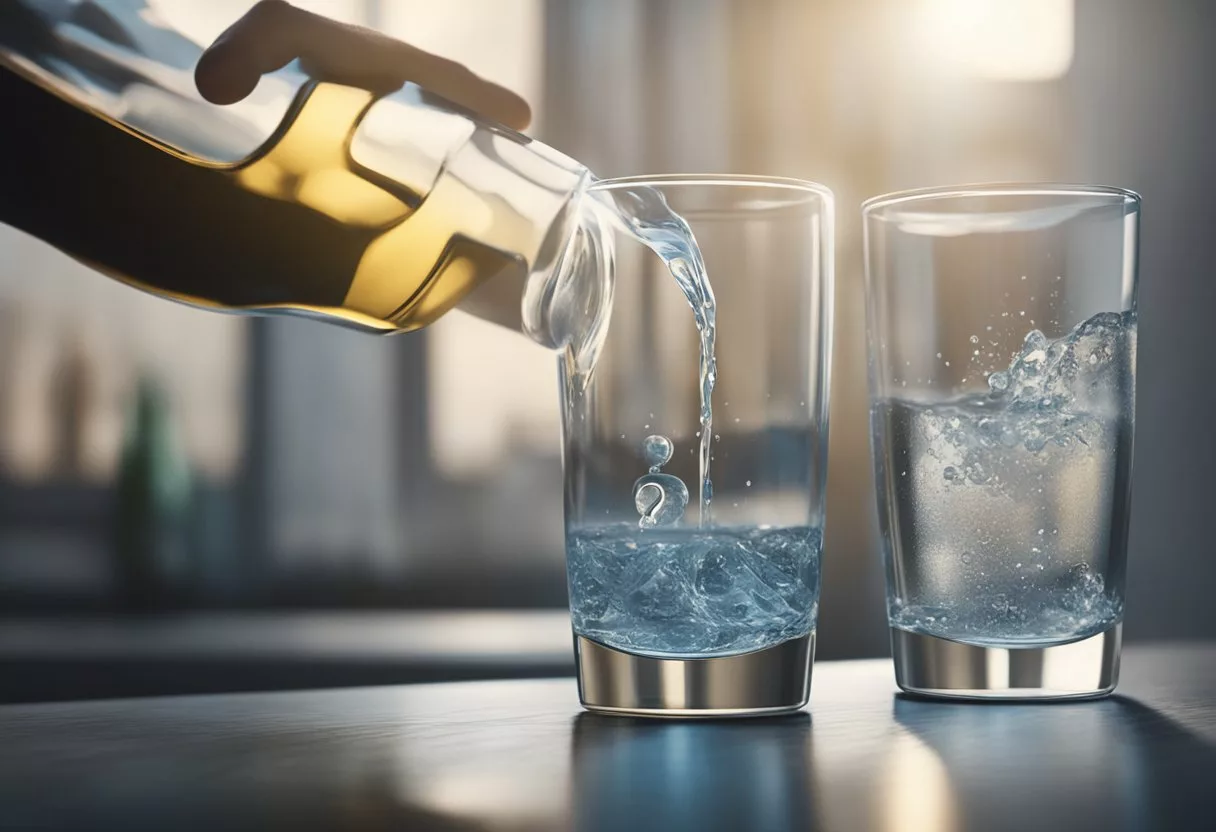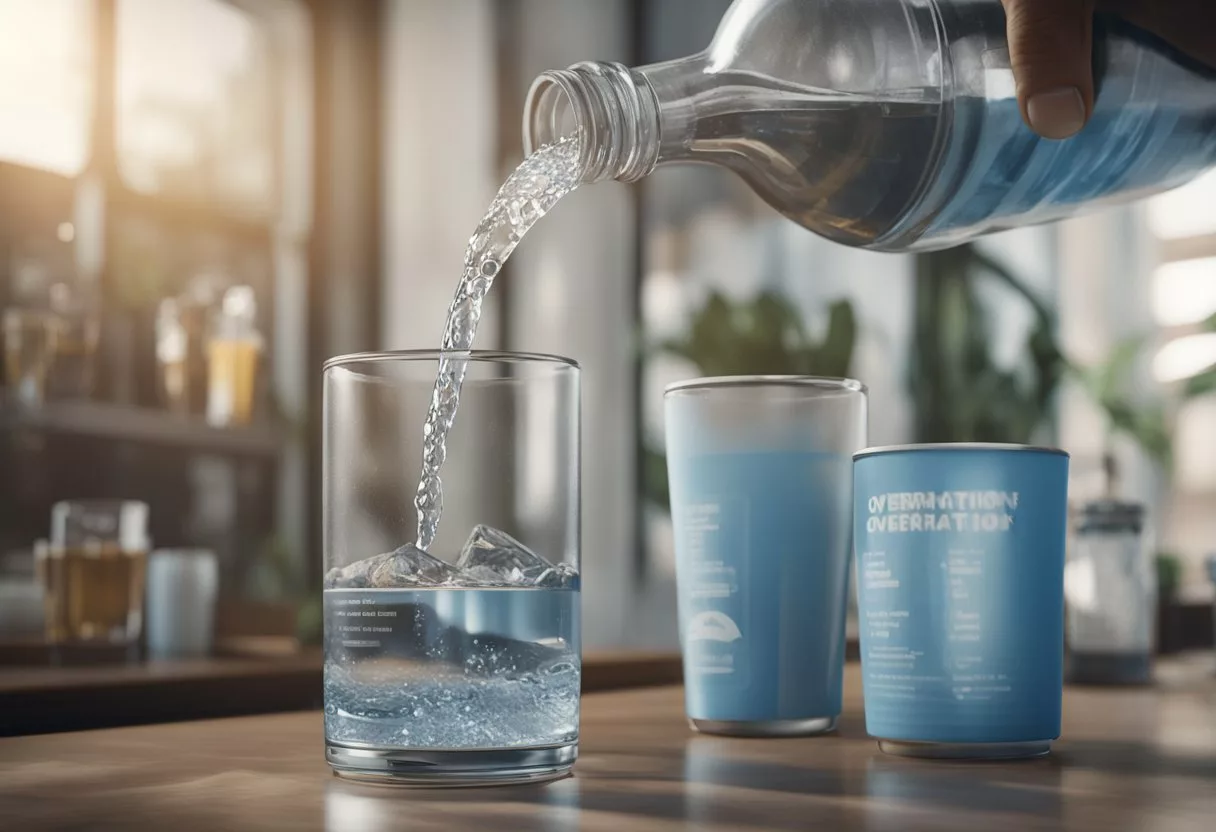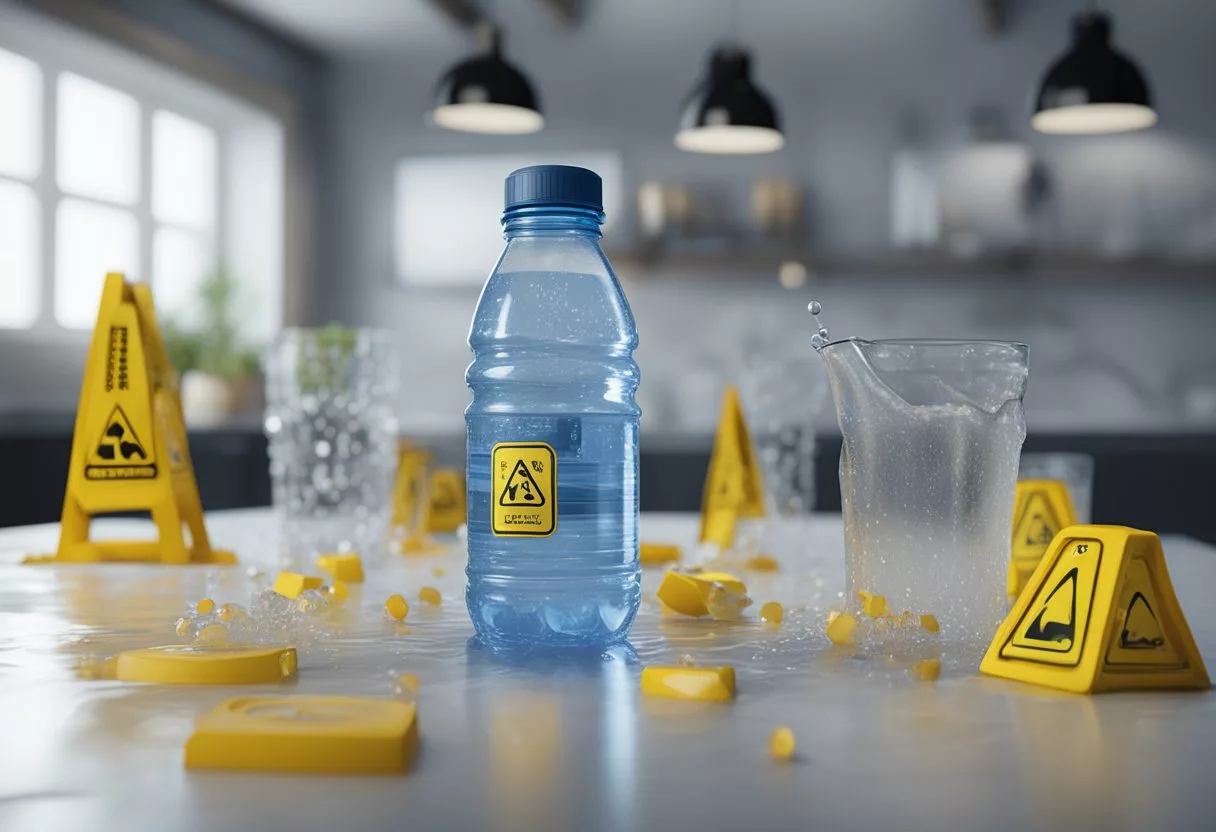Staying hydrated is vital for health, but drinking too much water can be harmful. Overhydration happens when you consume more water than your body needs, disrupting the balance of essential electrolytes like sodium. To avoid overhydration, experts recommend sipping water slowly throughout the day instead of consuming large amounts at once.
Signs of overhydration include headache, nausea, swelling, and confusion. In severe cases, too much water can lead to a potentially deadly condition called water intoxication. It’s critical to recognize these symptoms and adjust your water intake accordingly.
Different people need different amounts of water based on their age, activity level, and health conditions. It’s crucial to tailor your hydration habits to your personal needs and listen to your body’s signals.
Key Takeaways
- Sipping water slowly helps prevent overhydration.
- Recognize symptoms like headache and nausea related to excess water intake.
- Tailor hydration to individual needs and activity levels.
Understanding Hydration and Overhydration

Proper hydration is essential for the body to function correctly, but consuming too much water can lead to serious health issues. Understanding the balance between hydration and overhydration is key to maintaining good health.
The Role of Water in the Body
Water is vital for various bodily functions. It helps maintain the balance of bodily fluids, which is necessary for digestion, absorption, circulation, and temperature regulation. Water also supports the transport of nutrients to cells and the removal of waste products from the body.
Additionally, water plays a significant role in keeping the skin hydrated and maintaining its elasticity. Around 60% of the human body is made up of water, highlighting its importance in overall health.
What is Overhydration?
Overhydration occurs when the body takes in more water than it can expel. This can lead to a condition known as hyponatremia, where the blood’s sodium levels fall too low. Sodium is an essential electrolyte that helps regulate water balance in and around cells.
When sodium levels drop, water can move into cells, causing them to swell. This is particularly dangerous for brain cells, leading to symptoms such as headaches, nausea, vomiting, and, in severe cases, seizures or coma. Overhydration often affects athletes who drink excessive water to avoid dehydration.
Differences Between Overhydration and Dehydration
Dehydration occurs when the body loses more water than it takes in. Symptoms of dehydration include thirst, dry mouth, dark urine, and dizziness. Severe dehydration can lead to fainting, low blood pressure, and rapid heart rate.
In contrast, overhydration involves an excess intake of water, leading to the dilution of electrolytes in the blood. Electrolyte imbalance, particularly low sodium levels, differentiates overhydration from dehydration.
Both conditions can disrupt the body’s normal functions and require appropriate management. Drinking water as needed, especially during exercise or heat exposure, helps maintain a healthy balance. It’s essential to listen to the body’s signals and avoid excessive fluid intake to prevent overhydration.
Recognizing Overhydration Symptoms

When someone drinks too much water, the body can show various symptoms. These can range from mild signs to very severe health problems.
Early Symptoms of Overhydration
In the early stages, symptoms can be subtle. One common sign is nausea. This feeling of sickness can be mistaken for other issues, making it hard to identify the real cause.
Another early symptom is a mild headache. The lack of salt in the blood can cause this. Confusion and disorientation can also occur. These symptoms happen because the brain cells start to swell, leading to mental fog.
People might also experience vomiting. Like with nausea, this can be misleading unless one considers their water intake. Fatigue and muscle cramping may also indicate early overhydration. These can be signs that the body’s balance of nutrients has been disrupted.
Severe Overhydration Symptoms
In more severe cases, symptoms become dangerous. Seizures can happen when the body’s electrolyte balance is severely off. These can be life-threatening and need immediate medical attention.
Other severe signs include swelling of the brain, which can lead to a coma. This swelling occurs due to a significant drop in sodium levels, leading to water entering the brain cells.
Extreme confusion can also occur. This happens because the brain is severely affected by the swelling. This symptom can make it extremely difficult for individuals to perform regular tasks or recognize their surroundings.
In the most severe cases, overhydration can lead to death. It’s crucial to monitor water intake and recognize these symptoms early to prevent serious health issues.
For more details on overhydration, visit the Healthline article on overhydration or read about common symptoms from doctors.
Risk Factors and Causes

Overhydration is the result of exceeding the body’s water needs, which can lead to serious health problems. Certain groups and conditions make individuals more vulnerable to this risk.
High-Risk Groups
Age and activity level can play significant roles in overhydration. Athletes, especially those in endurance sports like marathons and triathlons, are susceptible because they often consume large amounts of water during events. Their high physical activity levels create a unique challenge in balancing hydration.
Older adults may also be at risk due to a decreased ability to regulate fluids. Their body’s hydration signals can be less effective, causing them to either under- or over-consume water. Children face similar risks because they may not recognize thirst accurately and could drink excessively, especially during sports or play.
Sex could impact hydration needs; some research suggests women may be more prone to overhydration due to lower body water composition compared to men. Generally, women have a higher percentage of fat tissue, which contains less water than lean tissue.
Influence of Medications and Health Conditions
Certain medications and health conditions can affect the body’s fluid balance. For instance, diuretics increase urine production, and some people might drink excess water to compensate, risking overhydration. Nonsteroidal anti-inflammatory drugs (NSAIDs) can also interfere with kidney function, impacting fluid regulation.
Individuals with kidney disease are prone to fluid retention and might mismanage their water intake. People with congestive heart failure need strict fluid intake monitoring to prevent complications.
Some underlying conditions, such as hyponatremia, might result from or lead to overhydration. Hyponatremia, or low sodium levels, can occur when large volumes of water dilute the sodium in the bloodstream, leading to dangerous health issues. It is particularly critical in the context of the body’s overall health where other systems and medications are involved.
Awareness of these factors can help in managing hydration effectively, ensuring water intake matches the body’s requirements without causing harm.
Preventing Overhydration

Understanding how much water your body needs can help prevent overhydration. By assessing individual fluid needs and following proper fluid intake recommendations, you can maintain a healthy balance.
Assessing Individual Fluid Needs
Fluid needs can vary based on body weight, physical activity, and climate.
For example, someone in a hot climate may need more water than someone in a cooler one. Physical activity also increases fluid requirements.
To estimate your water needs, consider your weight and activity level. A general guideline is to drink half your body weight in ounces of water per day. If you weigh 150 pounds, aim for 75 ounces of water daily.
Consulting with a healthcare professional can provide more personalized advice.
Fluid Intake Recommendations
Specific guidelines can help avoid excessive water intake. Adults should aim for around 9 cups (2.2 liters) of fluids per day for women and 13 cups (3 liters) for men.
To prevent overhydration, it’s important not to exceed these amounts significantly.
Pacing your water intake throughout the day and not drinking more than 800-1000 milliliters per hour can also help.
Include all fluids in this count, such as broths and teas. Children have different needs; for instance, kids aged 4-8 should drink about 1.2 liters, while those aged 9-13 should aim for 1.8 liters daily.
Pay attention to your body’s signals and adjust as needed to stay hydrated without overdoing it.
Strategies for Monitoring Hydration Status

Monitoring hydration involves simple methods like checking urine color and using technology. It also requires attention to electrolyte balance to avoid overhydration.
The Importance of Electrolyte Balance
Electrolytes such as sodium, potassium, magnesium, and chloride are crucial for the body’s fluid balance. Overhydration can dilute these electrolytes, leading to dangerous conditions like hyponatremia, where the blood’s sodium levels drop too low. Maintaining electrolyte balance helps the kidneys function properly and ensures that urination occurs at a healthy frequency. Monitoring the intake of these key nutrients is essential. For those at risk, including endurance athletes, it may be wise to consult with a healthcare professional to tailor a hydration plan that supports electrolyte stability and kidney health.
Use of Urine Color as an Indicator
Urine color is a straightforward method to gauge hydration. Clear urine often indicates overhydration, while dark yellow urine points to dehydration. The ideal urine color is light yellow. Concentration levels help determine this balance. Regularly checking the color can help individuals stay within a healthy hydration range. It’s a quick, non-invasive indicator that anyone can use daily. Some may opt to use urine tests for more detailed analysis, especially if they have a complex medical history or specific hydration needs. This method aligns with recommendations to keep hydration in check and avoid the extremes of intake.
Technology and Hydration Tracking
Modern technology offers various tools to track hydration. Apps on smartphones and wearable devices can monitor fluid intake and remind individuals to drink water. These apps can also log information about urination, body weight, and activity levels. Some advanced devices even analyze sweat composition to provide a more accurate reflection of hydration and electrolyte status. Using these tools can simplify the process and provide real-time feedback. They can be especially helpful for athletes and those with medical conditions that affect hydration. Utilizing technology to monitor hydration can enhance efficiency and ensure accurate, timely adjustments to fluid intake.
Health Implications and Treatment

Overhydration can lead to serious health problems, including electrolyte imbalances and brain swelling. It is important to recognize symptoms early and seek appropriate treatment. Not all cases are severe, but knowing when to seek medical help is crucial.
Complications of Overhydration
Drinking too much water can disrupt the body’s balance of electrolytes, such as sodium. This condition, called hyponatremia, causes sodium levels in the blood to drop dangerously low.
Brain cells can swell due to hyponatremia, leading to headaches, disorientation, and even seizures. The nervous system can also be affected, causing conditions like the syndrome of inappropriate antidiuretic hormone.
Other symptoms include fatigue and trouble breathing. These complications highlight the importance of monitoring water intake and recognizing early signs.
Approaching Treatment
Treatments for overhydration focus on restoring the body’s electrolyte balance. Doctors often limit fluid intake and may administer intravenous sodium solutions.
In some cases, diuretics help the body expel excess water. Nonsteroidal anti-inflammatory drugs can reduce swelling and discomfort. It’s essential to follow medical advice closely.
Medical professionals should tailor treatments to the individual’s needs. This personalized approach ensures the best outcomes and minimizes potential risks.
When to Seek Medical Help
Recognizing when to seek medical help is critical. Symptoms like confusion, severe headaches, and difficulty breathing require immediate attention.
If you suspect overhydration, consult a doctor promptly. They can perform tests to determine the extent of the imbalance and recommend appropriate treatment.
Ignoring symptoms can lead to severe complications. Early intervention can prevent lasting damage to the brain and other organs, ensuring a swift recovery.
Lifestyle Considerations and Practical Tips
Managing hydration is essential to prevent overhydration while meeting fluid needs. Here are some practical tips for athletes, dietary adjustments, and considering weather conditions.
Proper Hydration in Sports and Fitness
Athletes should balance fluid intake to match their training intensity. Drinking water in small sips before, during, and after exercise helps maintain hydration without overloading the body. Sports drinks can be beneficial during long or intense workouts as they contain electrolytes like sodium and potassium which aid in preventing electrolyte imbalance.
Avoid consuming excessive plain water, which can dilute blood electrolytes. Monitor urine color; pale yellow indicates good hydration. Dark urine signals dehydration, while clear urine might indicate overhydration.
Dietary Adjustments
Diet plays a significant role in managing hydration. Including foods with high water content like fruits and vegetables can aid fluid intake naturally. Cucumbers, oranges, and strawberries are good options.
Adding a bit more salt to meals during heavy training periods can help retain water and maintain electrolyte balance. Avoid excessive consumption of diuretic beverages like tea and juice that might lead to more frequent urination and loss of fluids.
Understanding Weather and Environmental Impacts
Weather and climate significantly affect hydration needs. Hot and humid conditions increase sweating, leading to higher fluid loss. It’s vital to drink water more frequently in such weather to prevent dehydration. In cold weather, the body loses fluid through increased urination and respiration.
Adjusting fluid intake based on the environment helps maintain proper hydration. For instance, high altitudes may require more fluid due to respiratory water loss. Consider using a humidifier in dry climates to reduce the moisture lost during breathing.
By being mindful of these factors, individuals can manage their hydration effectively, whether they’re active or at rest.
Tailoring Hydration to Life Stages and Conditions
Hydration needs vary based on age, health conditions, pregnancy, and breastfeeding status. Specific guidelines can help ensure proper water intake for optimal health.
Hydration During Pregnancy and Breastfeeding
During pregnancy, women need more water to support the increased blood volume and amniotic fluid. Pregnant women are usually advised to drink about 2.3 liters of water each day.
Breastfeeding mothers require even more water, as producing milk depletes the body’s fluids. It is recommended that they drink about 3.1 liters per day. Adequate hydration is crucial to ensure both the mother and baby receive necessary nutrients.
Listening to the body’s signals is essential. Thirst, dark-colored urine, and dry skin can be signs of dehydration. Keeping a water bottle handy helps maintain sufficient intake throughout the day.
Adjustments for the Elderly and Children
Elderly individuals often have a reduced sense of thirst, which can lead to dehydration. They should aim for about 1.7 liters of water per day. Health conditions and medications can affect hydration needs, so consulting a doctor is important.
Children’s water requirements vary by age. For example, children aged 4-8 should drink about 1.2 liters daily. Older children (aged 9-13) need approximately 1.8 liters each day. Ensuring children drink enough during activities is key to preventing dehydration.
Small, frequent sips of water and incorporating hydrating foods like fruits and vegetables can help both the elderly and children meet their hydration needs.
Hydration and Chronic Health Conditions
Chronic health conditions like kidney disease and heart disease require careful management of water intake. For those with kidney disease, reduced fluid intake might be necessary to prevent fluid buildup and strain on the kidneys.
Heart disease patients need to balance hydration to avoid overburdening the heart. Their fluid needs can be affected by medications and should be monitored by a healthcare provider.
Conditions that influence antidiuretic hormone levels, such as diabetes insipidus, require tailored hydration strategies to maintain electrolyte balance. Regular discussions with a doctor help determine the right amount of water based on individual health status.
Frequently Asked Questions

Understanding how to avoid drinking too much water is essential to maintain good health. The following sections cover common symptoms, immediate steps to take, and guidelines for daily water intake.
What are the common symptoms of drinking too much water?
Common symptoms include headaches, nausea, and confusion. Overhydration also lowers the salt concentration in the blood, leading to swelling in cells, especially in the brain. This can cause symptoms like muscle cramps and weakness.
What are the immediate steps to take if someone is overhydrated?
If someone is overhydrated, they should stop drinking water immediately. Seek medical attention, especially if symptoms are severe like confusion or seizures. A healthcare provider might recommend electrolyte replacement or other treatments.
What are the potential negative effects of excessive water intake?
Excessive water intake can lead to hyponatremia, a condition where the blood’s sodium level becomes dangerously low. This can cause swelling in cells, leading to symptoms like headaches, nausea, muscle cramps, and even more severe effects such as seizures.
How can an individual determine the appropriate amount of water intake daily?
To avoid overhydration, individuals should aim to drink 9-13 cups of fluids daily. This includes all types of fluids, not just water. Listening to the body’s signals like thirst can also help determine the right amount.
What is the maximum amount of water intake per hour to avoid overhydration?
It is generally recommended to drink no more than 1 liter, or approximately 4 cups, of water per hour to avoid overhydration. Drinking too much water in a short period can overwhelm the kidneys’ ability to excrete it.
How does the water intake recommendation vary between men and women?
Water intake recommendations differ between men and women. Men should aim for around 13 cups (3 liters) of fluids daily, while women should aim for around 9 cups (2.2 liters) daily. These recommendations include all beverages, not just water.